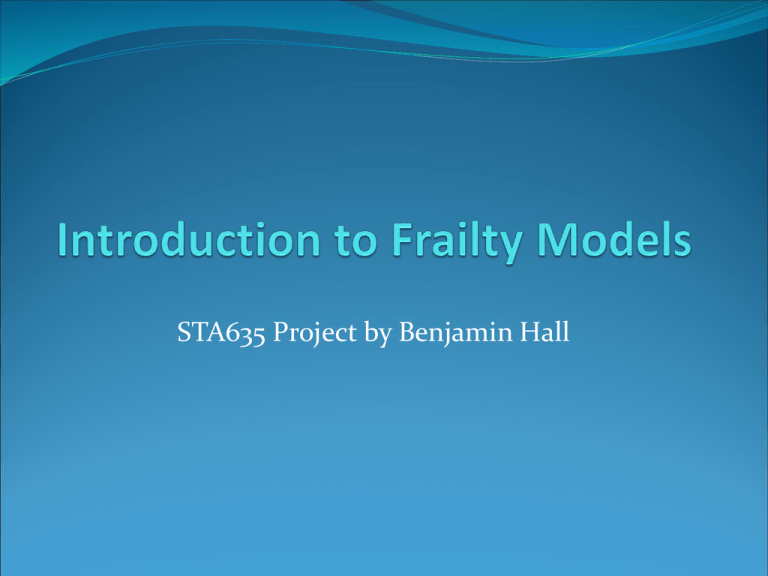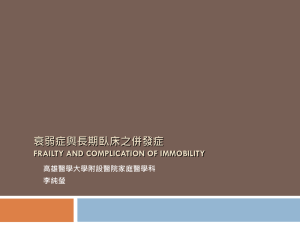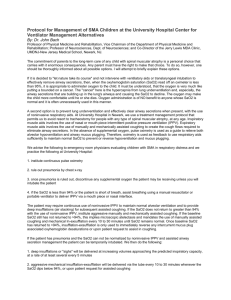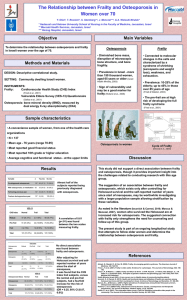
STA635 Project by Benjamin Hall
Cox proportional hazards model
Model: hyi (t) = h0(t)e1X1+...+ kXk is the hazard function
of the ith individual
Assumption: The hazard function for each individual
is proportional to the basine hazard, h0(t). This
assumption implies that the hazard function is fully
determined by the covariate vector.
Problem: There may be unobserved covariates that
cause this assumption to be violated.
Simluation Ex: Unobserved covariate
Consider a situation with the following population:
Group
Proportion of
Population
Hazard Rate Hazard Rate
with placebo with Drug A
1
40%
1
.5
2
40%
2
1
3
20%
10
8
Obviously Drug A is effective for the entire population.
But what happens in the Cox Model if the group is
unobservable?
Simulation Example, continued
Let’s simulate this example and apply the Cox model:
Have R simulate 100 people according to the previous
table’s probabilities and randomly assign them to
treatment or placebo
For each person, have R simulate # of incidents within
period of length 1. At the end of period of length 1
right-censoring occurs.
Simulation Example, continued
Here is some of the data generated by R (see final slide
for code):
id
group
treat
time
status
1
3
0
.38
1
[2,] 1
3
0
.07
1
[3,] 1
3
0
.23
1
[4,] 1
3
0
.15
1
[5,] 1
3
0
.11
1
[6,] 1
3
0
.89
0
[7,] 2
3
1
.22
1
[8,] 2
3
1
.04
1
...
...
...
...
...
[1,]
...
Simulation Example, continued
Now we run coxph on our data:
> myfit1
Call:
coxph(formula = Surv(time, status) ~ treat)
coef
exp(coef) se(coef) z
p
treat
-0.128
0.88
0.11
-1.17 0.24
Likelihood ratio test=1.37 on 1 df, p=0.242 n= 445
Notice that the LRT has a p-value of .242 which is not
significant. But we know that treatment is effective for
everyone. What is happening?
Simulation Example, continued
The problem is that we have heterogeneity in the data
due to the unobservable groups.
Since we cannot include group in our model, the
assumption of proportional hazards is violated.
What can we do to solve this problem? Use a frailty
model.
Frailty Model
Frailty models can help explain the unaccounted for
heterogeneity.
Frailty Model: hyi (t) = z h0(t)e1X1+...+ kXk is the
hazard function of the ith individual
The distribution of z is specified to be, say, Gamma.
(Note: z must be non-negative since the hazard is nonnegative.)
In this situation, the shared frailty model is
appropriate, that is multiple observations of the same
individual always has the same value of z.
Frailty Model in R
Let’s apply the frailty model to our simulated data:
> myfit2
Call:
coxph(formula = Surv(time, status) ~ treat + frailty(id))
coef se(coef) se2 Chisq DF
p
treat
-0.147 0.160
0.111 0.85
1.0
3.6e-01
frailty(id)
93.89 43.5 1.4e-05
Iterations: 5 outer, 17 Newton-Raphson
Variance of random effect= 0.294 I-likelihood = -1887.9
Degrees of freedom for terms= 0.5 43.5
Likelihood ratio test=117 on 44.0 df, p=1.37e-08 n= 445
Notice that the LRT now has a highly significant p-
value.
Frailty Model in R
Now let’s try implementing the frailty model to a real
data set, the kidnet data set.
Here are the results for the regular Cox Model:
> kfit1
Call:
coxph(formula = Surv(time, status) ~ age + sex, data = kidney)
coef exp(coef) se(coef)
z
p
age 0.00203 1.002
0.00925 0.220 0.8300
sex -0.82931 0.436
0.29895 -2.774 0.0055
Likelihood ratio test=7.12 on 2 df, p=0.0285 n= 76
Here the LRT is significant with a p-value of .0285 even
without considering frailty.
Frailty Model in R
However, a frailty model seems applicable in this
situation since their are multiple oberservations (i.e. 2
kidneys) per person. Below considers frailty:
> kfit2
Call:
coxph(formula = Surv(time, status) ~ age + sex + frailty(id), data = kidney)
coef se(coef)
se2 Chisq DF p
age
0.00525 0.0119 0.0088 0.2 1 0.66000
sex
-1.58749 0.4606 0.3520 11.9 1 0.00057
frailty(id)
23.1 13 0.04000
Iterations: 7 outer, 49 Newton-Raphson
Variance of random effect= 0.412 I-likelihood = -181.6
Degrees of freedom for terms= 0.5 0.6 13.0
Likelihood ratio test=46.8 on 14.1 df, p=2.31e-05 n= 76
Now the LRT is even more significant.
Resources
Therneau and Grambsch, Modeling Survival Data,
Chapter 9
Wienke, Andreas, “Frailty Models”,
http://www.demogr.mpg.de/papers/working/wp2003-032.pdf
Govindarajulu, “Frailty Models and Other Survival
Models”,
www.ms.uky.edu/~statinfo/nonparconf/govindarajulu.
ppt
R Code
library(survival)
#GEN_TIME
gen_time <- function(group, treat) {
if (group == 1) {
return (round(rexp(1, 1-(.5*treat)),2))}
if (group == 2) {
return (round(rexp(1, 2-treat),2))}
if (group == 3) {
return (round(rexp(1, 10-2*treat),2))}}
# PERSON DATA
person_data <- function() {
treat <- rbinom(1,1,.5)
x <- runif(1)
t1 <- matrix(NA, nrow=1, ncol=25)
if (x < .4) { group <- 1 }
if (x > .4 & x < .8) { group <- 2}
if (x > .8) { group <- 3}
elapse <- 0
count <- 1
while (elapse < 1) {
t1[(count+3)] <- gen_time(group, treat)
elapse <- elapse + t1[(count+3)]
count <- count + 1}
count <- count - 1
t1[1] <- group
t1[2] <- treat
t1[3] <- count
for (i in (count+4):25) { t1[i] <- 0 }
if (count == 1) { t1[count+3] <- 1 }
if (count > 1) { t1[count+3] <- 1-t1[count+2] }
return (t1)}
m1 <- matrix (NA, nrow=100, ncol=25)
for (i in 1:100) {
m1[i,] <- person_data() }
samp_size <- sum(m1[,3])
samp <- matrix(NA, nrow = samp_size, ncol= 5)
colnames(samp) <- c("id", "group", "treat", "time", "status")
count2 <- 1
for (i in 1:100) {
for (j in 1:m1[i,3]) {
samp[count2, 1] <- i
samp[count2, 2] <- m1[i,1]
samp[count2, 3] <- m1[i,2]
samp[count2, 4] <- m1[i,j+3]
samp[count2, 5] <- 1
if(j==m1[i,3]) { samp[count2, 5] <- 0 }
count2 <- count2 + 1}}
myfit1 <- coxph(Surv(samp[,4], samp[,5]) ~ samp[,3])
myfit2 <- coxph(Surv(samp[,4], samp[,5]) ~ samp[,3] + frailty(samp[,1]))
myfit1
myfit2












